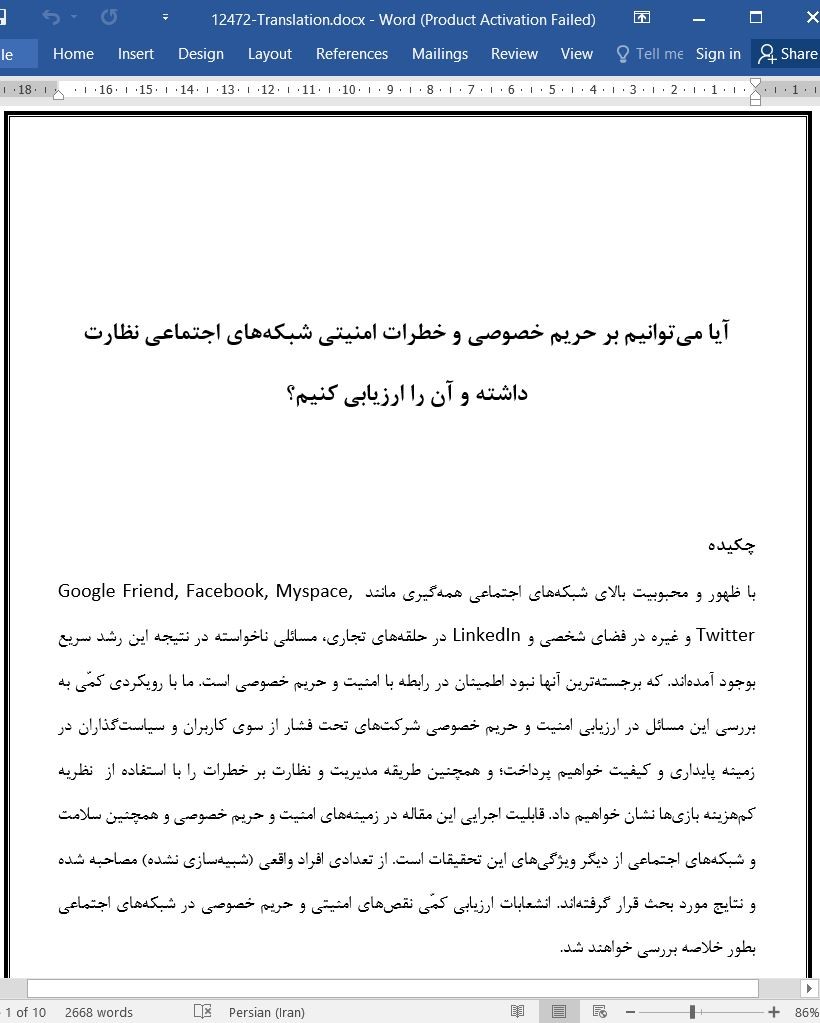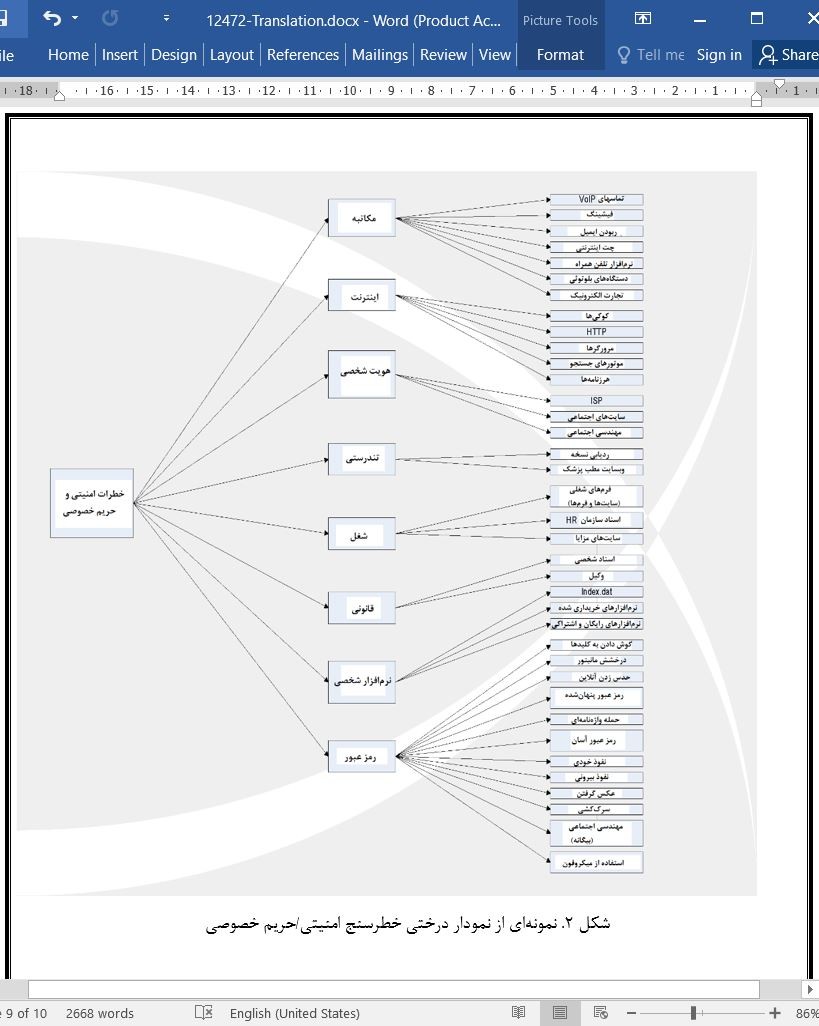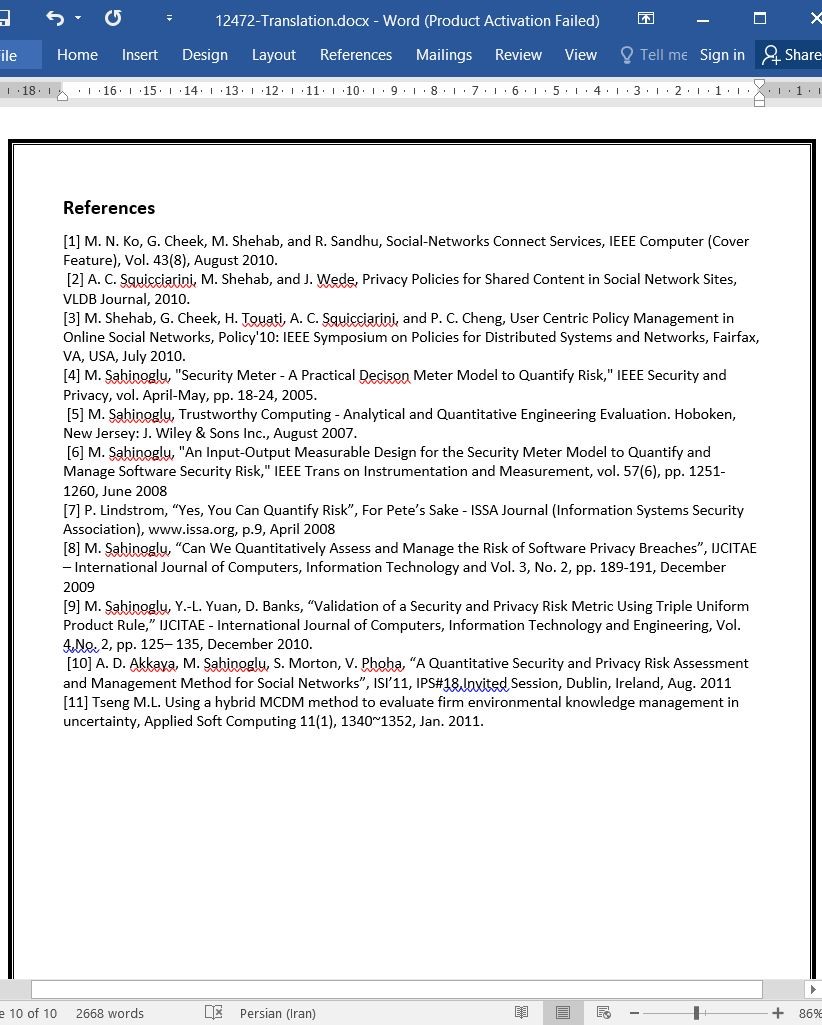
دانلود مقاله آیا می توانیم بر حریم خصوصی و خطرات امنیتی شبکه های اجتماعی نظارت داشته و آن را ارزیابی کنیم؟
چکیده
با ظهور و محبوبیت بالای شبکه های اجتماعی همه گیری مانند Google Friend, Facebook, Myspace, Twitter و غیره در فضای شخصی و LinkedIn در حلقه های تجاری، مسائلی ناخواسته در نتیجه این رشد سریع بوجود آمده اند. که برجسته ترین آنها نبود اطمینان در رابطه با امنیت و حریم خصوصی است. ما با رویکردی کمّی به بررسی این مسائل در ارزیابی امنیت و حریم خصوصی شرکت های تحت فشار از سوی کاربران و سیاست گذاران در زمینه پایداری و کیفیت خواهیم پرداخت؛ و همچنین طریقه مدیریت و نظارت بر خطرات را با استفاده از نظریه کم-هزینه بازی ها نشان خواهیم داد. قابلیت اجرایی این مقاله در زمینه های امنیت و حریم خصوصی و همچنین سلامت و شبکه های اجتماعی از دیگر ویژگی های این تحقیقات است. از تعدادی افراد واقعی (شبیه سازی نشده) مصاحبه شده و نتایج مورد بحث قرار گرفته اند. انشعابات ارزیابی کمّی نقص های امنیتی و حریم خصوصی در شبکه های اجتماعی بطور خلاصه بررسی خواهند شد.
1. مقدمه
شبکه های اجتماعی و خدمات آن به طرز شگفت انگیزی رشد کرده اند، اما چالش های امنیتی و مرتبط با حریم خصوصی نیز بیشتر شده اند (1)، (2)، (3). یک دلیل عمده برای وجود خطاهای امنیتی و حریم خصوصی، حجم بسیار بزرگ اطلاعات پردازشی روزانه سایت ها می باشد که سوءاستفاده از یک درز را در سیستم به کاری آسان بدل می کند. خدماتی مانند پیام ها، دعوت ها، تصاویر، برنامه های کاربردی بسترباز و غیره، که کاربر را به مشارکت دعوت می کنند، معمولا از راههای دسترسی به اطلاعات شخصی می باشند، مخصوصا در Facebook. در سال پیش یک دانشجوی دکتری با آشکارسازی درزی در چهارچوب رابط برنامه نویسی شخص ثالث (API) Facebook که براحتی اجازه سرقت اطلاعات شخصی را میداد، در تیترهای کوچک خبری مطرح شد. این دانشجو و همکارانش متوجه شدند که برنامه های شخص ثالث Facebook، اطلاعات بیشتری (آدرس ها، تصاویر، علایق، غیره) از آنچه که برای اجرای نرم-افزار مورد نیاز است در اختیار توسعه دهندگان قرار میدهند (http://www.fastcompany.com/articles/2008/10/social-networkingSecurity.html). مشکلاتی مانند مسائل امنیتی و حریم خصوصی که هم اکنون شبکه های اجتماعی را گرفتار کرده است، تنها در صورتی برطرف می شوند که کاربران نگرش محتاطانه تری در رابطه با حریم خصوصی خود و چیزهایی که به اشتراک می گذارند داشته باشند. با رشد شبکه های اجتماعی، نظارت و حمایت از کاربران سخت تر می شود زیرا وظایف برنامه-نویسان امنیتی بیشتر می شود. این مسئله ما را به کار سختی مانند چگونگی اندازه گیری و کاهش خطرات با بودجه ای معین و بطور کم هزینه می رساند.
5. بحث و نتیجه گیری
با توجه به افزایش محبوبیت شبکه های اجتماعی، وجود درزهای امنیتی و حریم خصوصی در سایت هایی همچون MySpace و Facebook دور از انتظار نیست. با وجود بیش از 500 میلیون کاربر، تنها یک نفر برای ایجاد صدمات جدی کافی است. اما مسائل امنیتی و مسائل مرتبط با حریم شخصی موضوعاتی کاملا جداگانه هستند. مسائل امنیتی زمانی روی میدهند که یک هکر بتواند به کدگذاری محافظت شده یک سایت یا زبان نوشته شده آن دسترسی پیدا کند. در مسائل مرتبط با حریم خصوصی، آنهایی که شامل دسترسی غیرموجه به اطلاعات شخصی میشوند، الزاما دربرگیرنده درزهای امنیتی نمی باشند. افراد می توانند با تحت نظر گرفتن شما به هنگام وارد کردن رمز عبورتان به اطلاعات شخصی شما دسترسی پیدا کنند. اما هر دو نوع از این نفوذها معمولا در شبکه های اجتماعی رخ می دهند، زیرا هرکسی که به شبکه امنیتی یک سایت رخنه می کند، دری را برای دسترسی آسان به اطلاعات تمام کاربران باز کرده است. اما زیان اصلی یک کاربر از میزان استفاده آنها از شبکه های اجتماعی و میزان اطلاعات به اشتراک گذاشته آنان نشات می گیرد.
Abstract
With the advent and unprecedented popularity of the now ubiquitous social networking sites such as Google Friend, Facebook, MySpace, Twitter etc. in the personal sphere, and others such as LinkedIn in business circles, undesirable security and privacy risk issues have come to the forefront as a result of this extraordinary rapid growth. The most salient issues are mainly lack of trustworthiness; namely, those of security and privacy. We will address these issues by employing a quantitative approach to assess security and privacy risks for social networks already under pressure by users and policymakers for breaches in both quality and sustainability; and will also demonstrate, using a cost-optimal game-theoretical solution, how to manage and monitor risk. The applicability of this research to diverse fields from security to privacy and health care, as well as the currently popular social networks is an additional asset. A number of real people (not simulated) were interviewed and the results are discussed. Ramifications of this quantitative risk assessment of privacy and security breaches in social networks will be summarized.
1. Introduction
The social networks and their related services have grown rapidly, but so has unwanted security and privacy challenges [1], [2], [3]. A major reason social network security and privacy lapses exist simply results from the astronomical amounts of information the sites process each and every day that end up making it that much easier to exploit a single flaw in the system. Features that invite user participation - - messages, invitations, photos, open platform applications, etc. -- are often the avenues used to gain access to private information, especially in the case of Facebook. A Ph.D. candidate at Berkeley made small headlines last year when she exposed a potentially devastating hole in the framework of Facebook's third-party application programming interface (API) which allows for easy theft of private information. This candidate and her co-researchers found that third-party platform applications for Facebook gave developers access to far more information (addresses, pictures, interests, etc.) than needed to run the application (http://www.fastcompany.com/articles/2008/10/social-networkingsecurity.html). The problems now plaguing social networks, e.g.: security and privacy issues, can only be resolved if users take a more careful approach to what they share and how much privacy they value. With the growth of social networks, it's becoming harder to effectively monitor and protect site users and their activity because the tasks of security programmers become increasingly spread out. This brings us to the difficult task of how to measure risk and mitigate it within a certain budget in a costeffective manner.
5. Discussion and Conclusions
Given the rising popularity of social networks, it is little surprise that there have been numerous high profile breaches of security and privacy on sites such as MySpace and Facebook. With over 500 million members combined, all it takes is one single person to cause major damage. But security issues and privacy issues are entirely two different topics. A security issue occurs when a hacker gains unauthorized access to a site's protected coding or written language. Privacy issues, those involving the unwarranted access of private information, don't necessarily have to involve security breaches. Someone can gain access to confidential information by simply watching you type your password. But both types of breaches are often intertwined on social networks, especially since anyone who breaches a site's security network opens the door to easy access to private information belonging to any user. But the potential harm to an individual user really stems from how much a user engages in social networking sites, and especially the amount of information they're willing to share.
چکیده
1. مقدمه
2. روش ها
3. بکارگیری روش پیشنهاد در خطرات امنیتی/حریم خصوصی شبکه های اجتماعی
4. تصریح موارد بکارگیری در شکل 2 و جدول 2 و جدول 1 (ضمیمه) در رابطه با بررسی خطرات امنیتی و حریم خصوصی
5. بحث و نتیجه گیری
منابع
Abstract
1. Introduction
2. Methods
3. Application Of The Propose Method For Privacy /Security Risk In Social Networks
4. Clarifications For Applications In Figure 2 and Table 2 and Table 1 (Appendix) on Privacy and Security Risk Survey
5. Discussion and Conclusions
References
- اصل مقاله انگلیسی با فرمت ورد (word) با قابلیت ویرایش
- ترجمه فارسی مقاله با فرمت ورد (word) با قابلیت ویرایش، بدون آرم سایت ای ترجمه
- ترجمه فارسی مقاله با فرمت pdf، بدون آرم سایت ای ترجمه



